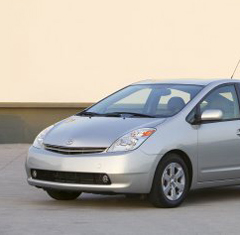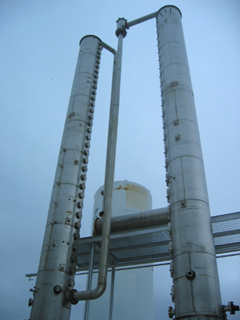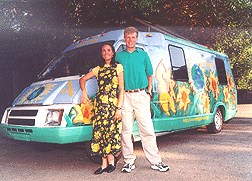May 6, 2005
Air Date: May 6, 2005
FULL SHOW
SEGMENTS
Driving Change: The Road to the Future
View the page for this story
We’ve always been a car-obsessed country. Two auto analysts, Danny Hakim of the New York Times and Walter McManus from the University of Michigan, help us take a look under the hood at the economics and psychology of our car culture, and how that’s changing as the price of gasoline goes up. (06:45)
Waste Not
View the page for this story
Part I: Some environmentalists and businesses are taking a new look at ethanol, the alcohol fuel now made from Midwestern corn. They believe expanding ethanol production to grass and crop waste could mean importing less gasoline and reducing greenhouse gas emissions. Host Bruce Gellerman talks with Brooke Coleman of the Renewable Energy Action Project about the promise of waste-based ethanol.
Part II:Our conversation on cellulosic ethanol continues with Jerry Marin of California’s Air Resources Board. He says his state doesn’t like ethanol. Brooke Coleman of the Renewable Energy Action Project responds. (10:40)
Expired Beverages
/ Lisa Ann PinkertonView the page for this story
Lisa Ann Pinkerton of WYEP in Pittsburgh continues our look at the new ethanol with a visit with two entrepreneurs who show you can make ethanol from old beer and soda. (04:30)
Veggie Van
View the page for this story
When Kaya and Joshua Tickell want a fill-up, they drive to the nearest fast food joint and ask for a helping of used vegetable oil, hold the fries. The Tickells take used cooking oil and turn it into clean-burning biodiesel fuel to power what they call their Veggie Van. Producer Bill George caught up with the pair on the road in Sarasota, Florida and has this sound portrait. (04:30)
Judgement Day
View the page for this story
“Heaven help us,” advises satirist Rich Pliskin and his Players of Princeton, New Jersey. If admission past the pearly gates depends on what we drive, some of us may be in trouble. (02:30)
Science Note/Lemon Cleaner
View the page for this story
Living on Earth's Katie Olivieri reports how a touch of lemon juice could clean up diesel engines and their emissions. (01:45)
The Segway Revolution?
View the page for this story
Three and a half years ago, the Segway was so top secret it needed a code name: Ginger. When it was finally revealed in December 2001, it was hailed as a device that would change the face of transportation. Host Bruce Gellerman visits the Segway headquarters in Bedford, New Hampshire to see how the human transporter has lived up to the hype. (07:30)
NASCAR's Lead Foot
/ Jeff YoungView the page for this story
Jeff Young goes to the race track to track down one of the last uses of leaded gasoline: NASCAR racing. Lead in gas is linked to brain damage and at least one environmentalist is pushing the racers to switch to unleaded. NASCAR says they're trying but it's not an easy task. (07:15)
This week's EarthEar selection
listen /
download
Show Credits and Funders
Show Transcript
HOST: Bruce Gellerman
GUESTS: Danny Hakim, Walter McMannus, Brooke Coleman, Jerry Martin,
REPORTERS: Lisa Ann Pinkerton, Jeff Young
NOTE: Katie Oliveri
(THEME MUSIC)
GELLERMAN: From NPR - this is Living on Earth.
(THEME MUSIC – UP AND UNDER)
GELLERMAN: I’m Bruce Gellerman. Americans love their cars—big—but with rising gas prices, you’d think U.S. automakers might try to shift our affections to fuel-efficient models. Think again, says an industry analyst. Detroit is stuck in reverse.
HAKIM: When Toyota and Honda were creating hybrids, General Motors was creating the Hummer brand.
GELLERMAN: As they plan the future of the automobile, who’s in the driver seat? We kick the tires and look under the hood of the auto industry. Also, Indy 500 drivers are getting the lead out of their fuel, but NASCAR’s are still in the slow lane.
MAN: It has been banned throughout the world even in far-flung places like Kazakhstan. If Kazakhstan can get rid of lead in gasoline, why can’t NASCAR?
GELLERMAN: Driving change—the road to the future. This week on Living on Earth. Stick around.
[NPR NEWSCAST]
ANNOUNCER: Support for Living on Earth comes from the National Science Foundation and Stonyfield Farm.
Driving Change: The Road to the Future

The 2005 Toyota Prius (Courtesy of Toyota)
GELLERMAN: From the Jennifer and Ted Stanley Studios in Somerville, Massachusetts, this is Living on Earth. I’m Bruce Gellerman, sitting in for Steve Curwood. We love our cars. Last year alone, Americans bought 17 million of them and we drive 1.3 billion miles a day, burning up 312 billion gallons of fuel each year in the process. So, how much are you paying for a gallon these days? The spike in oil prices, foreign policy concerns and worries about air pollution and global warming have ignited interest in alternative fuels and vehicles, accelerating a trend in the auto industry. Just last month, Japanese car makers Toyota and Nissan announced their U.S. sales soared by 25 percent while the fortunes of GM and Ford continued to sink. We turn to Walter McMannus. He’s director of the Office for the Study of Automotive Transportation at the University of Michigan and Danny Hakim. He’s the Detroit bureau chief for the New York Times. Hakim talks about what kinds of cars Americans are buying.
HAKIM: You know, in the 1990s, the big sport utility vehicles and large pickup trucks really started to gain a lot of ground. This year and over the last year, they’ve been slipping a little bit and it seems like consumers are shifting to smaller SUVs. They’re a bit more fuel efficient and part of that is just driven by the fact that automakers have started to produce a lot more of those small SUVs.
GELLERMAN: Where is the auto industry in the United States right now in terms of fuel efficiency and just responding to this whole gasoline crisis?
HAKIM: I would not characterize two dollars and what is it now? Fifty cents; that’s not a crisis. It’s not higher than it was in the ‘70s and it’s also about right where it was in the ‘40s before it fell during the ‘50s. So it’s, we’ve seen prices this high before and people still bought vehicles. But if you look at what’s available in the marketplace, there’s a huge number of vehicles, you don’t have to go hybrid, you don’t have to go car. You can get an SUV that has good fuel economy and something like 20 percent of all entries, all entries in the market have fuel economy that’s better than twice the median fuel economy. And that means there’s lots of choices and all people have to do is buy them.
|
GELLERMAN: Well, if the Japanese were so surprised by the sales of SUVs, are American carmakers surprised by the incredible sales of hybrids? HAKIM: Well, I wouldn’t say they’re incredible. I mean, so far there’s only a quarter of a million hybrid vehicles on the road in the U.S. And, you know, they sell more pickup trucks in a quarter than that so it’s not an incredible number. But it is having an incredible impact and I think what is surprising to the Detroit automakers is how quickly people have responded to the higher fuel prices. You know, the SUV sales being down 20 percent in the first quarter compared to a year ago, that’s very important. They’ve been saying for years people don’t care about fuel economy, they’ll keep buying these things, and they’re changing their behavior. MCMANNUS: But I would say there is very much still a debate in Detroit about the effect of higher gas prices on consumer behavior. General Motors is still pretty adamant that its customers aren’t affected by gas prices and it’s really not affecting purchase decisions. And, by contrast to that, Ford cited higher gas prices as a key factor in its lower earnings forecast for this year. And Ford executives are quite open in saying that, you know fewer people are buying these large SUVs because of gas prices. And, you know, in this era of rising gas prices, they have a pretty big bet on large SUVs and pickup trucks. And I think there’s a fair number of analysts that think there’s a risk to that. You know, if gas prices are going to be rising for some time or are going to be sustained at a higher level, is it a good position to be in for Ford and GM to have so much of your business banked on some of the least fuel efficient vehicles? GELLERMAN: But people are standing in line to buy one of these hybrid cars and Detroit has to literally give people money to buy one of their cars. HAKIM: That giving away money, I mean, when GM says that people are not responding to the gas price, they’re being a little disingenuous because over the past three years, they’ve increased the incentives on SUVs and the pickup trucks much more than they’ve increased the incentives on anything else. When they say there’s no effective fuel economy, yeah, if you lower the price. GELLERMAN: The average fuel efficiency of cars sold in the United States peaked in what? 1988? MCMANNUS: ’88. GELLERMAN: It was a little bit over 22 miles per gallon and now it’s down to less than 21 miles a gallon. We’re going backwards. MCMANNUS: Well, we’re not going backwards, we’re just not going forward. I mean, the decline within cars, within trucks, it’s gone up. The cars are more fuel-efficient than they were. Trucks are more fuel-efficient than they were. What’s happened is the shift, you know, the mix has shifted toward the trucks and so that’s why we’ve gone down. HAKIM: We’ve really become a country of truck buyers to a large extent. In 1980, about 80 percent of the vehicles sold in the U.S., the light duty vehicles were passenger cars. Today, less than half of the vehicles sold in the U.S. are passenger cars. GELLERMAN: Walter, looking down the road where is this industry going? MCMANNUS: Well, for the U.S., the industry is saturated, I mean they’re fully mature. There’s, the growth has been very slow, in terms of the total vehicles that are sold. It’s not going to be huge, but interestingly enough it’s still an attractive investment opportunity for the Japanese, the Koreans and maybe some day, a Chinese company is not only going to sell cars here, but they’re going to assemble them and build them here. And at a time when the American traditional big three are shrinking and they’re closing plants and they’re scaling back, here the other companies are coming here. GELLERMAN: Danny Hakim? HAKIM: I do think you’ll start to see the big three, the American automakers produce more fuel efficient cars going forward because it’s going to be a competitive issue rather than an environmental issue. When Toyota and Honda were creating hybrids, General Motors was creating the Hummer brand. I think going forward they’re going to have to reconcile with some of these environmental issues and with regulations that are tightening up around the world from China to Canada. California is pushing a tough new global warming regulation for automobiles. I think this is just going to become a business reality. GELLERMAN: Danny Hakim writes about the auto industry and is the Detroit bureau chief for the New York Times. Walter McMannus is the director of the Office for the Study of Automotive Transportation at the University of Michigan. I want to thank you both for being with us. MCMANNUS: You’re welcome. HAKIM: Thank you. Related link:
Waste NotGELLERMAN: There was once a time when happy motoring meant touring the USA in your Chevrolet and you even got service with a smile. Life seemed simpler then. [BANJO MUSIC: “And up through the ground, come a bubblin’ crude, oil that is…” ] GELLERMAN: But today, 50 or 60 bucks a fillup, Jed Clampit might have abandoned the old cement pond and chosen to stay on the family farm. Instead of drilling Texas tea, he might be distilling moonshine, ethanol. Since the 1990s, ethanol’s been required by some states as a gas additive to curb emissions. Now, with the price of gasoline sky high, the homegrown alternative fuel has President Bush’s support. BUSH: I like the idea of people growing corn. It gets converted into fuel for cars and trucks. Our farmers can help us become less dependent on foreign oil. GELLERMAN: With me to discuss the buzz about making ethanol from agricultural and industrial waste is Brooke Coleman of the Renewable Energy Action Project. Hi Brooke. COLEMAN: Thanks for having me. GELLERMAN: So, ethanol has been around for a long time. I mean, the Germans were using it, I think we were using it in World War II. COLEMAN: That’s correct. Ethanol in this country has been produced since the early part of the 20th century. The Model T, the Ford Model T, ran on both an ethanol blend and a petroleum blend. GELLERMAN: And in the ‘70s when they had the oil shock prices then in the long gas lines. Ethanol was in the news and people were using it. So, what’s new here is that, instead of making it from corn, now we can make it from other things. COLEMAN: Correct. There’s a term called cellulosic ethanol and the end product is the same. However, cellulosic ethanol comes from the leaves, stems and stalks of the plants instead of just the fruits and the seeds. So if today’s ethanol producers grow corn to harvest a corn kernel, tomorrow’s producers may be choosing from rice, wheat, oat, barley, straw, switch grass. Some companies even want to make it out of urbanized waste streams and municipal waste and even stale beer. GELLERMAN: So, how much ethanol is the United States using right now as fuel in gasoline? COLEMAN: Oh, it’s about just over three billion gallons of ethanol, around three billion gallons and that is still a fairly small percentage of the United States’ overall consumption of gasoline, which is up around 130 billion gallons a year. GELLERMAN: So, it can be used to extend the supply of gasoline? COLEMAN: It can. GELLERMAN: And I was reading it can increase octane levels and it can decrease engine emissions. COLEMAN: That’s true. GELLERMAN: What’s new now is that we can use all of these other waste products, now why is that new? Couldn’t we have taken all this waste and turned it into fuel before? COLEMAN: The reason that that’s new is to produce ethanol from the stems and stalks of a plant as opposed to say the corn kernel. There’s another step in the production process. The corn kernel is what people refer to as a fermentable carbohydrate. That means that it ferments easily into a fuel-grade alcohol. The stems and stalks have to be broken down into a fermentable carbohydrate and that involves a variety of methods and the one that many investors see as the future of the industry is using micro-organisms to break the plant matter down into a fermentable carbohydrate. GELLERMAN: And those are novel micro-organisms, or you can get them in any store? COLEMAN: No, you can’t get them in any store. There are companies that are working on putting these enzymes on the market and what that allows is a more efficient production of ethanol. GELLERMAN: I know there’s a big controversy over whether you are actually getting a yield, an energy yield for using corn for ethanol production because you have to have oil to have the tractors and you have to have pesticides, chemical-based, herbicides and all that kind of stuff. COLEMAN: That’s correct and it’s a responsible question to ask. In the last five to six years, ethanol production efficiency has increased significantly and the Department of Energy in several studies has confirmed that there’s a positive net energy balance. But the point here is to let, allow the industry to further mature, to implement more efficient production strategies and to move toward cellulosic ethanol, which is far more efficient. GELLERMAN: And then you could have distilleries or fermenters all over the country. You wouldn’t be dependent upon just a few refineries at either end of the country. COLEMAN: And that is one of the reasons that the oil industry is so opposed to ethanol production. They know that it’s a naturally decentralized industry. They know that there are not as significant barriers to entry as there are now. I mean there are a few upstart environmental entrepreneurs that are considering opening an oil refinery, however, there are several that are considering opening an ethanol refinery. GELLERMAN: What is the potential of what you’re calling cellulosic ethanol? COLEMAN: The potential is great. We’re talking on the order of 150 billion gallons by 2050 and presuming that our consumption of liquid fuels increases over 150 billion gallons by 2050, that still represents a majority of our consumption of liquid fuels, which would create jobs, tax revenue, fuel diversification, increase competition in the marketplace and reduce CO2 emissions which is where we need to go. [MUSIC: Lester Flatt & Earl Scruggs “The Ballad of Jed Clampett” Television Themes: 16 Most Requested Songs (Columbia) 1994] GELLERMAN: We’re talking with Brooke Coleman of the Renewable Energy Action Project about the promise of cellulosic ethanol. Coming up—California just says no to the stuff. It already has its fill. That’s just ahead on Living on Earth. [MUSIC: G Love & Special Sauce “Lay Down the Law” Yeah, It’s That Easy (Okeh) 1997] GELLERMAN: It’s Living on Earth. I’m Bruce Gellerman. Brooke Coleman of the Renewable Energy Action Project is a big fan of filling up our cars with ethanol made from waste. We’ll continue our conversation with him but first, California leads the nation in the use of clean fuels including ethanol. And because of its expertise curbing auto emissions, other states, even other countries, seek the advice of California’s Air Resources Board. But agency spokesman Jerry Martin says the Air Resources Board doesn’t share Brooke Coleman’s enthusiasm for waste-based ethanol. MARTIN: The state of California and the Air Resources Board have some reservations about ethanol largely because we have done studies on granted older vehicles that show that using large amounts of ethanol increases nitrogen oxide emissions. Nitrogen oxides are the building block of photochemical smog and another problem we have with ethanol, of course, is that ethanol for California is an import product, which means that California drivers will have to pay an added cost to have ethanol put in their gasoline. GELLERMAN: But California growers raise rice, you’ve got vineyards, you’ve got some of the largest agricultural areas in the country. MARTIN: That’s correct. As a matter of fact, the state Air Resources Board has sponsored research projects to develop ethanol from rice straw as a way of helping rice growers in the Sacramento Valley get rid of the straw. We have nothing against ethanol, but we recognize some limitations with the product. GELLERMAN: But you’re also fighting the federal government to get out of using ethanol in gasoline. MARTIN: That’s correct. Largely because we don’t think it’s necessary. Cars built today are equipped with mechanical and electronic solutions to the problems that oxygenates in gasoline solved in the early ‘90s. GELLERMAN: But Jerry, you know, as goes California, so goes the nation. Investors are watching California to see what you do with the waste ethanol, to give it a green light or not. Aren’t you depriving the rest of the country of a relatively clean renewable fuel? MARTIN: We don’t think so and as I said earlier we are not against ethanol, we are just against a requirement demanded in Washington that California use an oxygenate when we don’t think it’s necessary. We think it adds to our air pollution burden and, of course, this is the most polluted state in the nation with 75 percent of the health-threatening pollution occurring here. We cannot afford to add a product to our fuel which we know will increase air pollution. Right now, ethanol is just another product Californians would have to pay for in their fuel. GELLERMAN: Jerry Martin is spokesman for the California Air Resources Board. Jerry, thank you very much. MARTIN: Thank you. GELLERMAN: Brooke Coleman, you’re with the Renewable Energy Action Project and maybe this is not such a bright horizon as you were thinking originally? COLEMAN: Well, we don’t agree with that position. There is a zone of disagreement basically. We don’t think that the evidence suggests that ethanol blends worsen air quality. In fact, ethanol has been used in some states since the mid ‘80s. Not a single state that has replaced either MTBE, which is the old oxygenate, with ethanol has ever had a documented air quality problem. And it’s important to point out here that every major city in this country monitors smog every hour of every day, 365 days a year. And so, when ethanol’s been used for two and a half decades and there’s no empirical evidence to suggest that the cities that use it have problems, then I think it’s time to move onto the more important issues here. And that’s petroleum displacement, global warming, job creation, and creating tax revenue in the state of California. GELLERMAN: Brooke, is it possible that the rest of the country could increase its use of this waste ethanol and California do what it’s doing and the country would be better off or worse off, but that this could happen without California? COLEMAN: It could, but when the California Air Resources Board comes out and says something, the rest of the country listens. And that’s true across the board for environmental policy makers. GELLERMAN: But you said yourself, that, you know, in Midwest states they’re using this to a greater extent already. COLEMAN: That’s correct, but we, there’s an opportunity here. And California’s the biggest consumer of gasoline in the country. To move a major, major sector of the transportation market toward what we believe is a more sustainable fuel use, I mean, we’re talking about; I mean look at California’s situation right now. They are blending 900 million, almost a billion gallons of ethanol. And their position to give refineries flexibility is basically, let refiners use as much ethanol as they want. And what that sounds like to the average consumer is, hey, flexibility is usually good. Well, what that sounds like for someone trying to develop an ethanol plant is a waste of money because you don’t build a 40-million dollar ethanol plant and hope that the refineries are going to use it. GELLERMAN: Brooke, you mentioned that the petroleum companies are seemingly not all for this, they’ve got a vested interest in petroleum, so how do you create a market for this? COLEMAN: One of the ways is you get several plants up and running. You know, the government says, hey, this is worth it from a public policy perspective. We’re going to invest, you know, a billion dollars, over the next 25 years and we’re going to get four or five plants up and running and we’re going to have a deployment strategy. And if it doesn’t work, you know we’re going to have reinsurance and insure the people based on performance. GELLERMAN: Brooke Coleman is with the Renewable Energy Action Project in Massachusetts and Brooke, thank you very much. COLEMAN: Thank you. Related links:
Expired Beverages
Distillation towers of the New Companies plant where the beer will be boiled into alcohol/ethanol. (Photo: Lisa Ann Pinkerton) GELLERMAN: Well, despite questions about the use of ethanol, a growing number of entrepreneurs are betting on the future of making the alternative fuel out of all sorts of stuff and starting up ethanol refineries that don’t use corn. Lisa Ann Pinkerton of WYEP in Pittsburgh has the story of two enterprising men in Ohio who are about to start making car juice-out of expired “brewski.” PINKERTON: There may still be debate on what happens to city air when ethanol is mixed with gasoline. Nevertheless, the Clean Air Act of 1990 continues to require smoggy cities to blend oxygenates into their gas. And at a gas station along the rainy, Ohio turnpike, drivers are none the wiser. MAN: Isn’t that like corn substitute or something like that? WOMAN: I have no idea about gas. All I know is I just fill up my car. I don’t know what’s in there. STUDENT: I’m not sure to be honest with you. SALESMAN: It doesn’t bother me one way or the other. I mean I’ve got to drive. PINKERTON: As long as the Federal Government requires ethanol, Ohio will be a large purchaser. This reality combined with an idiosyncrasy in the beverage business made one group of investors see a future in stale beer and soda. Just outside of Cleveland, Liquid Resources recycles whole pallets of expired beverages, all the way from the cardboard and plastic to brew inside, which can be converted into valuable ethanol. COOK: You know, what we used to do is just take it to the dump. And the dump's eating all the glass. It’s a landfill you know. PERRY: The whole state of Pennsylvania and all of southern Ohio is doing exactly the same thing. COOK: Yeah, right. PINKERTON: Liquid Resources clients are people like Steve Cook of Knoll Beverage. He wholesales around two million cases to greater Cleveland each year. But if products expire before they’re sold, the state requires him to destroy the controlled substance if he wants to get his valuable excise taxes back. This means taking it to a dump or burning it at hazardous waste facility. COOK: In terms of if it’s recycled, we’re not even sure. PINKERTON: But at Liquid Resources, Cook can avoid bureaucratic red tape, get his taxes back sooner and better the environment all at the same time. [SOUNDS OF WAREHOUSE, SAWING, CRUSHING] PINKERTON: On the warehouse floor, amongst a sea of pallets, glass bottles are crushed and the liquid that was once useless appreciates in value as it trickles into a tank below. [GLASS FALLING] PINKERTON: The glass shards left over fall into a dumpster outside to be recycled. Yellow tubing, snaking across the warehouse floor, carries the discarded beverage to its new destiny. As Co-founder Tim Curtis follows it, he says the plant could convert anything made with corn syrup. CURTIS: Colas, juices, pop tart filling--products like that that have sugar are great products for us. PINKERTON: At the opposite end of the warehouse, Curtis props a door open with a rock, before stepping toward two towering distillation columns, about three stories high.
|














